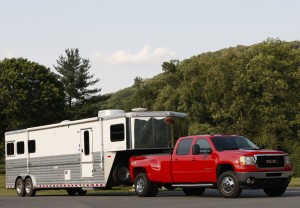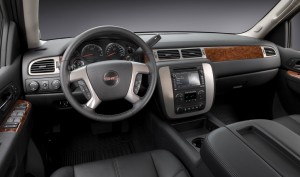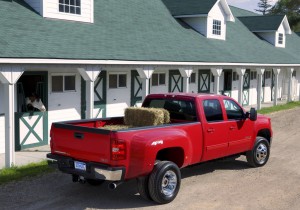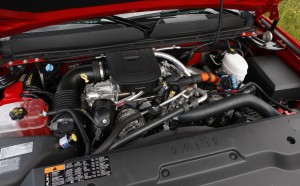Nobody’s ever going to mistake one of these big rigs for a sports car, but it would be nice if changing lanes in one didn’t make you have visions of driving a semi truck.
People who buy heavy-duty trucks like this GMC Sierra Heavy Duty don’t have any expectations about taking on Mazda Miatas on a race track. But they might appreciate communicative steering that allows for easy handling when the worksite is down a twisty road or when it’s time to quickly change lanes on the freeway.
There’s no getting around the fact that a 7,387-pound 259-inch-long truck is ponderous. Make it a “dualie” – double rear wheels – and it gets even more difficult. Parking it is always a chore, usually requiring a three-point turn.
But everything is relative. Relative to Ford, the other major player at the top of the heavy duty heap, GM’s trucks seems somewhat easier to maneuver.
Credit the truck’s communicative steering that helps the Sierra do a reasonable impersonation of a mega-sized, 78-inch tall Corvette.
This summer, Ford crowed loudly that it had found an additional 12 horsepower and 65 lb.-ft. of torque through a simple computer upgrade and it was adding a few well-placed pieces of high-strength steel to increase it’s F-Series Super Duty’s payload capacity. The changes were designed to do one thing: allow Ford to reclaim the title as most powerful and most capable heavy-duty pickup truck.
But in reality, it doesn’t matter all that much. Both of these trucks offer serious capabilities and the numbers are within shouting distance of each other. The GMC’s optional 6.6-liter diesel makes 397 horsepower. The Ford is 400. Ford wins in torque 800 to 765. The GMC can carry up to 6,635 pounds. The Ford is rated to carry 7,070 pounds.
While the Ram Heavy Duty also has extreme capabilities, it just can’t keep up with the bruisers from Ford and GM.
Both the GMC and Ford can carry a pair of Ford Fiestas (although stacking them might be a difficult trick), with enough capacity left over to slide in a decent-size motorcycle. Both can tow a fifth wheel trailer that would rival some houses.
So you might as well choose the one that drives the best, has the best styling, the best interior or has the feature that is most important to you.
The GMC’s steering makes the Sierra easier to drive. But the stiff ride is sometimes uncomfortable on certain sections of freeways, particularly sections of concrete that have a rhythmic pattern of small bumps.
The interior is somewhat boring, but well built and finished. The controls fall readily to hand and work well but the design is not up to what Ford and Ram offer on their supersize pickup trucks. There’s not as much visual firepower. That might be a selling point for a buyer favors a more conservative design over the ritzy Ford or flashy Ram.
The same goes for the exterior styling. Where the Ram is shapely and the Ford is bold, the GMC wears conservative clothing. There’s not as much differentiation from its regular-duty brethren as there is between the Ford Super Duty and the regular F-150.
This isn’t necessarily a criticism. Some buyers will appreciate the GM trucks’ less ostentatious styling.
In terms of engine performance, the GMC’s performance is just as shocking. Both of these rigs accelerate as though they’ve been pushed by some otherworldly force. For Boeing’s next jumbo jets, it might want to seek proposals from Ford and GM to provide the thrust.
Unfortunately, the GM diesel might not as efficient as the Ford’s. While mega-sized trucks are not required to carry fuel economy ratings, we averaged 15 miles per gallon in mostly freeway driving in the Sierra, while the Ford averaged 17 mpg in a combination of rural two lanes and freeways. To be fair, this wasn’t a direct apples-to-apples comparison. While the Ford is, of course, available as a dualie, the test truck was a single rear wheel. Being a dualie cost the Sierra mpgs.
Like all of the domestic pickups, the Sierra is available in so many configurations, it would seem possible that no two will be exactly alike.
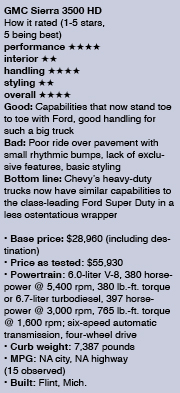 There are three cabs, regular, extended and crew; two bed lengths, two engines and a choice of rear-wheel drive or four-wheel drive.
There are three cabs, regular, extended and crew; two bed lengths, two engines and a choice of rear-wheel drive or four-wheel drive.
During an earlier drive, we took a regular-cab Chevrolet Silverado HD, a twin of the Sierra, on a 700-mile trip to serve as lighthouse keepers at Crisp Point Lighthouse in the Upper Peninsula.
The Silverado was powered by the standard 6.0-liter gasoline V-8, but it was still easily up to the challenge of pulling our 2,500-pound camper. A couple of times, we used four-wheel drive to power through soft sand on the poorly maintained dirt road that leads to the 106-year-old lighthouse, but otherwise, the truck barely knew the little camper was behind it.
The Ford beats the GM trucks on available features. Ford offers optional features such as cool steps that allow easy access to the bed, ToolLink, which can actually help you keep track of your tools and Sync, the best infotainment system available.
The Ford also rides a little better, although the GM trucks’ better steering response helps it feel more agile in traffic.
The Ford and GM trucks are all supremely capable trucks. Choosing between them should come down to styling preferences, features and differences in ride and handling. Their capabilities and engine output numbers are so close that the differences hardly matter.

